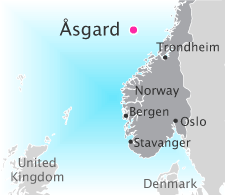?sgard Subsea Gas Compression Installation Commences
The installation of the subsea gas compression system has commenced on the Statoil-operated Åsgard field in the Norwegian Sea. The technology marks the beginning of a new era in offshore production technology.
The compression system, built by Aker Solutions, is being installed at a depth of 300 meters and will generate an extra 282 million barrels from the Åsgard field, extending its life by 20 years.
 This functionality brings the industry a step closer to having a fully-functioning production and processing system on the seafloor. Gas compressors have already been installed on platforms to maintain output as reservoir pressures drop over time. Placing them on the seabed and near wellheads improves recovery rates and reduces capital and operating costs. Subsea compression also leaves a smaller environmental footprint and is safer to operate than a platform, says Aker Solutions head of technology, Hervé Valla. “The Åsgard project is an industrial game-changer that has the potential to significantly impact the subsea production market.”
This functionality brings the industry a step closer to having a fully-functioning production and processing system on the seafloor. Gas compressors have already been installed on platforms to maintain output as reservoir pressures drop over time. Placing them on the seabed and near wellheads improves recovery rates and reduces capital and operating costs. Subsea compression also leaves a smaller environmental footprint and is safer to operate than a platform, says Aker Solutions head of technology, Hervé Valla. “The Åsgard project is an industrial game-changer that has the potential to significantly impact the subsea production market.”
Compression provides the driving force necessary to ensure a high gas flow and level of extraction and can contribute to significant improvements both in the level of extraction and operational life of a number of gas fields. Subsea processing, and gas compression in particular, is an important technology for developing fields in deep water and in exposed areas, says Statoil.
A Special Installation
The Åsgard project will see two 11.5MW subsea compressors installed in a 74 x 44 x 20m subsea station weighing around 4,800 tons. A total of 22 modules will be installed and connected to make up two identical compressor trains weighing 1,500 tons each.
The installation work is being carried out by the North Sea Giant, which was rebuilt for the purpose. The modules vary in size, and the smallest are being installed via the vessel's moonpool. Modules with a maximum weight of up to 70 tons can be installed in this way. However, several of the modules are too large for installation via the moon pool, and the ship's crane system has been modified to incorporate a so-called special handling system.
 This lifting system is designed to carry a load of up to 420 tons and can operate in up to nine-meter high waves. Each module is lowered into the sea via a crane and guided into place with a ROV and cables.
This lifting system is designed to carry a load of up to 420 tons and can operate in up to nine-meter high waves. Each module is lowered into the sea via a crane and guided into place with a ROV and cables.
"This crane system makes the installation work safer and more efficient. To ensure quality at every stage of the process, all operational crew have practiced the operations in a specially designed simulator. We have also performed a number of sea trials prior to installation," says project director Torstein Vinterstø.
The installation sequence has been carefully planned so that start-up work can be carried out on the first compressor train while work to install modules on train two continues.
Åsgard Gas
Åsgard ranks among the largest developments on the Norwegian continental shelf, including a total of 52 wells drilled through 16 seabed templates. Gas compression on the seabed will increase extraction from the Mikkel and Midgard reservoirs in the Åsgard field outside Trøndelag.
Gas from Åsgard is piped to the Kårstø processing complex, north of Stavanger. The heavier components, such as ethane, propane, butane and naphtha are separated out at Kårstø. The dry gas is piped to continental Europe. Åsgard supplies about 11 billion cubic meters of gas annually to European customers.
 Statoil Looking to Innovate Further
Statoil Looking to Innovate Further
Statoil is leading the industry in the deployment of subsea equipment. Statoil CEO Eldar Sætre recently stated that over the last ten years, the cost of subsea developments has increased by 250 percent. According to analysts Douglas-Westwood, subsea spending will continue to rise, but Sætre has plans to deal with that.
Sætre says that the rule has been that every operator- and almost every project - has tailor made their own solutions to their seemingly unique challenges. “Increased standardization could become a game changer. We think of it as putting LEGO blocks on the seabed, and we are working together with our suppliers to achieve this mission.”
As yet Douglas-Westwood (DW) forecasts do not include subsea processing equipment hardware, but it is viewed as a growing trend that will be vital to enable long-term production from a number of fields. “At the moment however people are waiting to see what happens with Åsgard before going forward,” says Ben Wilby, author of DW’s report World Subsea Hardware Market Forecast 2015-2019.
Wilby says that global subsea hardware Capex will total $145 billion between 2015 and 2019, representing growth of more than 27 percent compared with the preceding five-year period.
Meanwhile Sætre calls for fundamental change, embedded into a more sustainable performance culture to help the industry manage development costs. “Standardization, simplification and industrialization. Not yet words that are immediately associated with our industry. But the potential is large in many areas.”
